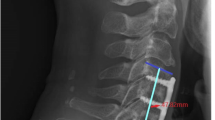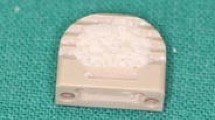Abstract
From July 2004 to June 2005, 19 patients with 25 discs underwent anterior cervical discectomy and interbody fusion (ACDF) in which polyetheretherketone (PEEK) cages were filled with freeze-dried cancellous allograft bone. This kind of bone graft was made from femoral condyle that was harvested during total knee arthroplasty. Patient age at surgery was 52.9 (28–68) years. All patients were followed up at least 1 year. We measured the height of the disc and segmental sagittal angulation by pre-operative and post-operative radiographs. CT scan of the cervical spine at 1 year was used to evaluate fusion rates. Odom's criteria were used to assess the clinical outcome. All interbody disc spaces achieved successful union at 1-year follow-up. The use of a PEEK cage was found to increase the height of the disc immediately after surgery (5.0 mm pre-operatively, 7.3 mm immediately post-operatively). The final disc height was 6.2 mm, and the collapse of the disc height was 1.1 mm. The segmental lordosis also increased after surgery (2.0° pre-operatively, 6.6° immediately post-operatively), but the mean loss of lordosis correction was 3.3° at final follow-up. Seventy-four percent of patients (14/19) exhibited excellent/good clinical outcomes. Analysis of the results indicated the cancellous allograft bone-filled PEEK cage used in ACDF is a good choice for patients with cervical disc disease, and avoids the complications of harvesting iliac autograft.
Résumé
De juillet 2004 à juin 2005, 19 patients ont bénéficié de 25 discectomies cervicales suivies d’arthrodèses intercorporéales (ACDF) avec l’utilisation de cages de type PEEK utilisant des allogreffes cryoconservées. Le matériel osseux a été obtenu à partir de condyles fémoraux récupérés lors d’une prothèse totale du genou. Matériel et méthode : la moyenne d’âge lors de la chirurgie a été de 52.9 ans (28 à 68). Tous les patients ont été suivis au moins un an. Nous avons mesuré radiologiquement la hauteur du disque et les angulations sagittales pré et post-opératoires. Afin d’évaluer la bonne fusion nous avons utilisé un scanner cervical un an après l’intervention. Les critères d’Odomi ont été appréciés de façon à évaluer le résultat clinique. Les disques arthrodésés sont considérés comme consolidés après un an post-opératoire. L’utilisation de cages de type PEEK semble améliorer la conservation de la hauteur du disque immédiatement après l’intervention (5.0 mm pré op, 7.3 mm post-op). La hauteur finale du disque étant de 6.2 mm et le collapsus du disque de 1.1 mm. La lordose segmentaire augmente également après l’intervention chirurgicale (2° en pré op et 6.6° immédiatement en post-opératoire) la perte de lordose est de 3.3° au dernier suivi. 74% des patients (14/19) ont un excellent résultat clinique. L’analyse de ces résultats nous indique que l’utilisation d’allogreffes cryoconservées associées à une cage de type PEEK dans l’arthrodèse cervicale permet d’obtenir une bonne fusion en évitant les complications secondaires à la prise de greffes iliaque.



Similar content being viewed by others
References
Arrington ED, Smith WJ, Chambers HG, Bucknell AL, Davino NA (1996) Complications of iliac crest bone graft harvesting. Clin Orthop 329:300–309
Boakye M, Mummaneni PV, Garrett M, Rodts G, Haid R (2005) Anterior cervical discectomy and fusion involving a polyetheretherketone spacer and bone morphogenetic protein. J Neurosurg Spine 2(5):521–525
Castro FP Jr, Holt RT, Majd M, Whitecloud TS 3rd (2000) A cost analysis of two anterior cervical fusion procedures. J Spinal Disord 13(6):511–514
Cho DY, Liau WR, Lee WY, Liu JT, Chiu CL, Sheu PC (2002) Preliminary experience using a polyetheretherketone (PEEK) cage in the treatment of cervical disc disease. Neurosurgery 51(6):1343–1349
Goulet JA, Senunas LE, DeSilva GL, Greenfield ML (1997) Autogenous iliac crest bone graft. Complications and functional assessment. Clin Orthop 339:76–81
Gu YT, Jia LS, Chen TY (2007) Biomechanical study of a hat type cervical intervertebral fusion cage. Int Orthop 31(1):101–105
Hwang SL, Hwang YF, Lieu AS, Lin CL, Kuo TH, Su YF, Howng SL, Lee KS (2005) Outcome analyses of interbody titanium cage fusion used in the anterior discectomy for cervical degenerative disc disease. J Spinal Disord Tech 18(4):326–331
Jones KC, Andrish J, Kuivila T, Gurd A (2002) Radiographic outcomes using freeze-dried cancellous allograft bone for posterior spinal fusion in pediatric idiopathic scoliosis. J Pediatr Orthop 22(3):285–289
Kao FC, Niu CC, Chen LH, Lai PL, Chen WJ (2005) Maintenance of interbody space in one- and two-level anterior cervical interbody fusion: comparison of the effectiveness of autograft, allograft, and cage. Clin Orthop 430:108–116
Katzer A, Marquardt H, Westendorf J, Wening JV, von Foerster G (2002) Polyetheretherketone-cytotoxicity and mutagenicity in vitro. Biomaterials 23(8):1749–1759
Niu CC, Chen LH, Lai PL, Fu TS, Chen WJ (2005) Trapezoidal titanium cage in anterior cervical interbody fusion: a clinical experience. Chang Gung Med J 28(4):212–221
Odom GL, Finney W, Woodhall B (1958) Cervical disk lesions. J Am Med Assoc 166(1):23–28
Schmieder K, Wolzik-Grossmann M, Pechlivanis I, Engelhardt M, Scholz M, Harders A (2006) Subsidence of the wing titanium cage after anterior cervical interbody fusion: 2-year follow-up study. J Neurosurg Spine 4(6):447–453
Shields LB, Raque GH, Glassman SD, Campbell M, Vitaz T, Harpring J, Shields CB (2006) Adverse effects associated with high-dose recombinant human bone morphogenetic protein-2 use in anterior cervical spine fusion. Spine 31(5):542–547
Smith GW, Robinson RA (1958) The treatment of certain cervical spine disorders by anterior removal of the intervertebral disc and interbody fusion. J Bone Joint Surg [Am] 40:607–624
Toth JM, Wang M, Estes BT, Scifert JL, Seim HB 3rd, Turner AS (2006) Polyetheretherketone as a biomaterial for spinal applications. Biomaterials 27(3):324–334
van der Haven I, van Loon PJ, Bartels RH, van Susante JL (2005) Anterior cervical interbody fusion with radiolucent carbon fiber cages: clinical and radiological results. Acta Orthop Belg 71(5):604–609
Wenz LM, Merritt K, Brown SA, Moet A, Steffee AD (1990) In vitro biocompatibility of polyetheretherketone and polysulfone composites. J Biomed Mater Res 24(2):207–215
Young WF, Rosenwasser RH (1993) An early comparative analysis of the use of fibular allograft versus autologous iliac crest graft for interbody fusion after anterior cervical discectomy. Spine 18(9):1123–1124
Author information
Authors and Affiliations
Corresponding author
Rights and permissions
About this article
Cite this article
Liao, JC., Niu, CC., Chen, WJ. et al. Polyetheretherketone (PEEK) cage filled with cancellous allograft in anterior cervical discectomy and fusion. International Orthopaedics (SICO 32, 643–648 (2008). https://doi.org/10.1007/s00264-007-0378-x
Received:
Revised:
Accepted:
Published:
Issue Date:
DOI: https://doi.org/10.1007/s00264-007-0378-x




